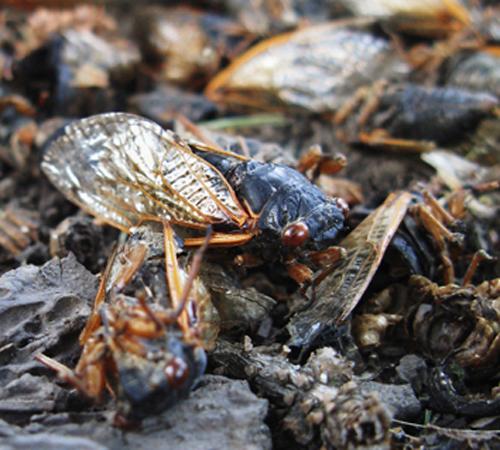Noisy cicadas disappearing for another 17 years

Cicada carcasses are seen at the base of a tree in Elmhurst, Ill., Thursday, July 5, 2007, as the periodical bugs die off, not set to return for another 17 years. While established towns such as Elmhurst, Villa Park, Westmont and Hinsdale heard the deafen Robert Graves, The Associated Press
July 9, 2007
CHICAGO – For weeks, Debbie Dethart refused to venture into her back yard to mow the lawn because swarms of noisy cicadas covered everything.
Lately though, the elementary school teacher from Homewood has spent a lot of time cleaning up bug carcasses as the 17-year periodical cicadas die off – not to return until 2024.
“I was shooing them away with a broom off the deck,” Dethart said. “I’m not a big bug person.”
But while she was battling the red-eyed, shrimp-sized, flying insects in Homewood, other towns were marked by a cicada-free silence.
Entomologists say the turnout of Brood XIII, although strong, was spottier and smaller than expected in some areas, likely because of land development over the past 17 years.
Get The Daily Illini in your inbox!
After periodical cicadas emerge and mate, their offspring burrow into the ground and feed on sap from tree roots until they’re ready to emerge again. When trees are removed – say, to build homes or farms – the cicada larvae go with them, experts said.
So, while established towns such as Villa Park, Elmhurst, Westmont and Hinsdale heard the deafening roar of cicadas’ mating calls – capable of overpowering ringing telephones, lawn mowers and power tools – developing areas like Batavia and Naperville were curiously quiet.
“The cicadas (were) not as widespread as they have been as some previous situations,” said Phil Nixon, an extension entomologist with the University of Illinois. “We’ve gotten quite a few calls from people in Chicago: ‘Why aren’t they here?'”
Cynthia Turski recalled when she was a 10-year-old and her Naperville backyard was so full of noisy cicadas that she couldn’t sleep. This time around, Turski, 27, was a little disappointed.
She saw and heard cicadas in Naperville, but not like she did in 1990.
“It was super loud, you could see them covering everything, but it was in smaller amounts,” she said.
Meanwhile, the hype surrounding this year’s emergence – from newspaper reports to blogs to apparel – may have caused some people to expect cicadas everywhere, all the time. That led to disappointment for some when June passed and the backyard remained silent.
“The media was trying to nail down an exact date,” said Daniel Summers, entomologist and collection manager for the Field Museum in Chicago. “There was an expectation that 7 billion were going to emerge on an exact date. Well, that’s not the way it works around here.”
For Turski, more cicadas would have been nice. Now that she’s older, her attitude toward the bugs has changed.
“I was fascinated instead of repulsed,” she said. “This year, I thought it was cool to drive by a wooded area or even just a tree and hear a wall of sound.”






